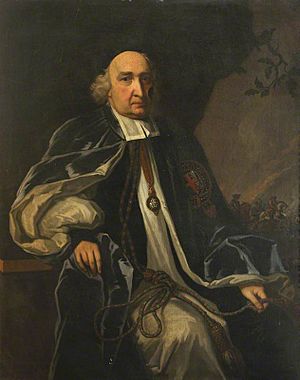Peter Mews facts for kids
Quick facts for kids The Right Reverend Peter Mews |
|
|---|---|
| Bishop of Winchester | |

Portrait by Michael Dahl
|
|
| Church | Church of England |
| Diocese | Winchester |
| Elected | 1684 |
| Reign ended | 1706 |
| Predecessor | George Morley |
| Successor | Jonathan Trelawny |
| Orders | |
| Consecration | 9 February 1673 by Gilbert Sheldon |
| Personal details | |
| Born | 25 March 1619 Caundle Purse, Dorset, England |
| Died | 9 November 1706 (aged 87) Farnham Castle, Surrey, England |
| Buried | Winchester Cathedral |
| Nationality | English |
| Denomination | Anglican |
| Residence | Farnham Castle (as Bishop of Winchester) |
| Parents | Elisha Mews & Elizabeth Winniffe |
| Spouse | Mary Baylie |
| Previous post | Archdeacon of Huntingdon (1649–1666) canon of Windsor (1662–1673) Archdeacon of Berkshire (1665–1673) President of St John's College, Oxford (5 August 1667–1673) Vice-Chancellor of Oxford University (1669–1673) Dean of Rochester (1670–1673) Bishop of Bath and Wells (19 December 1672 {elected}–November 1684) |
| Alma mater | St John's College, Oxford |
Peter Mews (born March 25, 1619 – died November 9, 1706) was an important English church leader. He was a Royalist, meaning he supported the King during the English Civil War. Peter Mews was a captain in the Royalist army. He was captured during a battle but later helped the Royalist cause in Scotland. He eventually became a Bishop in the Church of England.
Contents
Early Life and Education
Peter Mews was born in Caundle Purse, a small village in Dorset, England. He went to school at Merchant Taylors' School in London. After that, he studied at St John's College, Oxford, where he was a scholar and a fellow.
Service During the Civil War
When the Civil War began in 1642, Peter Mews joined the King's army. He became a captain. He was taken prisoner at the battle of Naseby, a major battle of the war.
After his release, he went to Holland in 1648. He became friends with King Charles I's secretary, Sir Edward Nicholas. Peter Mews was good at disguising himself. This skill was very helpful to the Royalists during the time Oliver Cromwell ruled England. He traveled to Scotland twice in 1653 to help the Royalist cause.
In August 1653, his friend Sir Edward Nicholas tried to get Peter Mews a job. He wanted him to be a philosophy teacher at the Orange College of Breda. However, Hyde said that the job needed someone who had spent more time studying.
Church Career and Leadership
Before these events, Peter Mews had become a priest. After the Restoration of the monarchy, he earned a degree called DCL. He also got his fellowship back at Oxford University.
He then held several important church positions:
- Archdeacon of Huntingdon
- Vicar of St Mary's, Reading
- Chaplain to the King
- Canon of Windsor
- Canon of St David's
- Archdeacon of Berkshire (from 1665 to 1672)
Leading Oxford University
In 1667, Peter Mews was in Breda, a city in the Netherlands. He was helping to arrange a peace treaty between England and the Dutch Republic. While there, he was chosen to be the President of St John's College, Oxford. He took over from his father-in-law, Richard Baylie.
Later, he became the Vice-Chancellor of Oxford University. This is a very important leadership role at the university. He also became the Dean of Rochester.
Becoming a Bishop
In 1672, Peter Mews was appointed Bishop of Bath and Wells. As a bishop, he was responsible for a large area. He kept an eye on families who did not follow the official Church of England. He paid special attention to Mary Speke and her family.
Peter Mews left his role as President of Oxford University in 1673. In 1684, he was elected Bishop of Winchester. He held this position until he died. People called him an "old, honest cavalier." He is buried in Winchester Cathedral.
Later Years and Influence
Peter Mews showed his loyalty to the King during the Battle of Sedgemoor. He even lent his own carriage horses to help pull cannons for the royal army. He was wounded during this battle while with the army.
However, he also supported the Seven Bishops. These bishops disagreed with some of King James II's actions. Peter Mews was sick and could not attend their meeting. As the visitor of Magdalen College, Oxford, he supported the students and teachers there. They were resisting King James II. He allowed their chosen leader, John Hough, to become president. In October 1688, he brought back the students and teachers who had been removed by the King.
In 1689, he swore loyalty to King William III and Queen Mary II. In 1691, he played a main part in making John Tillotson the Archbishop of Canterbury. This happened because Henry Compton, the Bishop of London, was not there.
Images for kids
There are two known portraits of Peter Mews. One is at Athelhampton Hall, a manor house in Dorset. The other portrait is in the Bishop's Palace in Wells.
Sources
| Academic offices | ||
|---|---|---|
| Preceded by Richard Baylie |
President of St John's College, Oxford 1667–1673 |
Succeeded by William Levinz |
| Preceded by John Fell |
Vice-Chancellor of Oxford University 1669–1673 |
Succeeded by Ralph Bathurst |
| Church of England titles | ||
| Preceded by Nathaniel Hardy |
Dean of Rochester 1670–1673 |
Succeeded by Thomas Lamplugh |
| Preceded by Robert Creighton |
Bishop of Bath and Wells 1673–1684 |
Succeeded by Thomas Ken |
| Preceded by George Morley |
Bishop of Winchester 1684–1706 |
Succeeded by Jonathan Trelawny |


